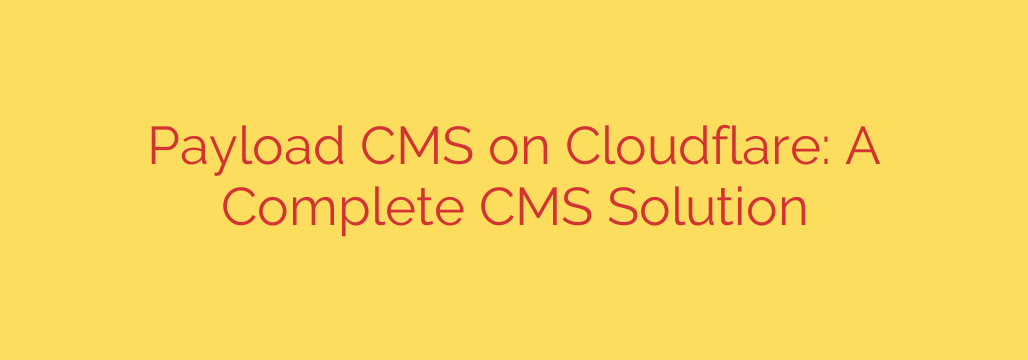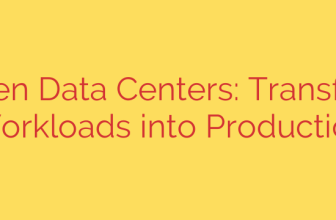
Unlock Ultimate Performance: A Guide to Deploying Payload CMS on Cloudflare
In the quest for faster, more secure, and infinitely scalable websites, developers are constantly seeking the perfect technology stack. Traditional monolithic systems often introduce bottlenecks, high costs, and complex maintenance. A modern approach, however, combines the flexibility of a headless CMS with the power of edge computing—and the combination of Payload CMS and Cloudflare is rapidly emerging as a definitive solution.
This guide explores why running Payload CMS on Cloudflare’s serverless platform is a game-changer for building next-generation web applications.
What is Payload CMS?
Payload is not just another content management system. It’s a developer-first, headless CMS built entirely in TypeScript, designed for those who need ultimate control and flexibility. Unlike restrictive, opinionated platforms, Payload provides a powerful foundation without getting in your way.
Its core strengths include:
- A Fully Customizable React Admin Panel: Build a content management experience perfectly tailored to your project’s needs. You have full control over the UI, from custom fields to entire application views.
- Powerful APIs Out of the Box: Payload automatically generates robust REST and GraphQL APIs based on your data schemas, providing instant, secure access to your content.
- TypeScript-First Architecture: Enjoy end-to-end type safety from your database to your front end, significantly reducing bugs and improving developer productivity.
- A Flexible, Field-Based System: Construct complex data models with ease using a rich library of field types, including blocks, arrays, and relationships.
Essentially, Payload gives you the backend logic and an elegant admin interface, freeing you to build your front end with any technology you choose.
Why Cloudflare is the Ideal Host for Modern Applications
For years, Cloudflare has been known for its world-class CDN and security services. Today, its platform has evolved into a comprehensive serverless ecosystem that allows developers to run entire applications at the edge, physically closer to users around the globe.
The key components for this architecture are:
- Cloudflare Workers: A serverless platform that allows you to run your application code (like Payload’s Node.js backend) across Cloudflare’s massive global network. This eliminates the need for centralized servers and drastically reduces latency.
- Cloudflare D1: A serverless SQL database built on SQLite. D1 provides the reliability and query power of a relational database without the complexity of managing server clusters.
- Cloudflare R2: An S3-compatible object storage solution perfect for hosting media files, images, and other assets. Its most compelling feature is the elimination of data egress fees, a major cost-saver compared to other cloud providers.
The Synergy: Why Payload and Cloudflare Are a Perfect Match
Combining Payload CMS with Cloudflare’s serverless stack creates a highly efficient and powerful system. This pairing isn’t just a trend; it offers tangible advantages that solve common web development challenges.
1. Unbeatable Performance and Low Latency
By deploying Payload on Cloudflare Workers, your entire application backend runs at the edge. When a user requests data, the logic is executed at a data center near them, not halfway across the world. This architecture, combined with a D1 database, delivers sub-second response times and a seamless user experience.
2. Infinite Scalability with Zero DevOps
Forget about provisioning servers or configuring auto-scaling groups. Cloudflare’s serverless infrastructure automatically scales to meet any traffic demand, from a few users to millions. Whether you have a sudden viral hit or predictable peak hours, your application remains fast and available without manual intervention.
3. Drastically Reduced Costs
Traditional hosting requires paying for idle servers. With a serverless model, you only pay for the resources you actually use. Furthermore, Cloudflare R2’s zero egress fee policy for object storage means you can serve images and videos without the fear of surprise bills, making it an incredibly cost-effective solution for media-heavy websites.
4. Built-in, World-Class Security
When you deploy on Cloudflare, you inherit its industry-leading security suite. Your application is automatically protected against DDoS attacks, malicious bots, and common vulnerabilities through its Web Application Firewall (WAF). This simplifies security management and hardens your application against threats.
Actionable Security Tips for Your Cloudflare-Powered CMS
While Cloudflare provides a secure foundation, you should still follow best practices to protect your application.
- Enable Cloudflare’s WAF with Managed Rulesets: Activate the Web Application Firewall and apply the OWASP Core Ruleset to block common attack vectors targeting your API endpoints.
- Use Cloudflare Access for Admin Panel Security: Protect your Payload admin dashboard by placing it behind Cloudflare Access. This enforces strong authentication (like SSO or multi-factor authentication) before a user can even reach the login page.
- Implement Rate Limiting on APIs: Prevent abuse and brute-force attacks by configuring rate limiting on your GraphQL and REST API endpoints. This ensures fair usage and protects your database from being overwhelmed.
- Secure Your Media with Signed URLs: If you store sensitive assets in R2, use signed URLs to grant temporary, secure access to files, preventing unauthorized hotlinking or direct access.
The Future of Web Development is at the Edge
The combination of Payload CMS and Cloudflare represents a paradigm shift in how we build and deploy web applications. It offers the development flexibility of a modern headless CMS and the performance, scalability, and security of a global edge network. By moving the entire stack closer to the user, you can deliver faster experiences, reduce operational overhead, and build more resilient applications. This powerful duo isn’t just a viable option—it’s the future of high-performance content management.
Source: https://blog.cloudflare.com/payload-cms-workers/








